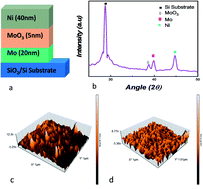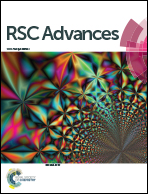A comprehensive investigation of MoO3 based resistive random access memory†
Abstract
The bipolar resistive switching of molybdenum oxide is deliberated while molybdenum and nickel are used as bottom and top electrodes, respectively, to present a device with resistive random access memory (RRAM) characteristics. For the trilayered structure, the SET voltage lies around 3.3 V and RESET voltage is observed to be in the −2.3 V to −2.7 V range. The conduction mechanism has been observed and revealed for the Metal–Insulator–Metal (MIM) structure which is a space-charge-limited current mechanism that follows both ohmic conduction and Child's law. Furthermore, a theoretical study has been performed by using density functional theory (DFT) to evaluate the resistance switching role of molybdenum oxide (MoO3). The structure has been studied with oxygen vacancy sites induced into the system which shows the reduction in bandgap, whereas an indirect bandgap of 1.9 eV and a direct bandgap of 3.1 eV are calculated for molybdenum oxide. Conclusively, the formation of a conduction filament which is fundamental for resistive switching has been explained through band structure and density of states per eV for oxygen vacancy structures of molybdenum oxide. The current work presents an in-depth understanding of the resistive switching mechanism involved in MoO3 based resistive random access memory devices for future data storage applications.



 Please wait while we load your content...
Please wait while we load your content...